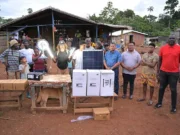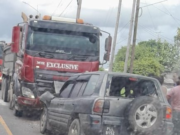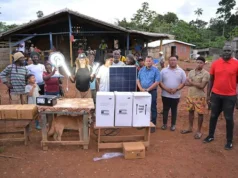A delegation of 10 experts from various local government entities recently participated in a week-long learning journey in Brazil from May 21 to 28, 2024.
The expedition was supported by the Food and Agriculture Organization of the United Nations (FAO) and included experts from both Guyana and Brazil.
The team from Guyana comprised of representatives from the Guyana Lands and Surveys Commission (GLSC), the National Agricultural Research and Extension Institute (NAREI), the Guyana Geology and Mines Commission (GGMC), the Ministry of Natural Resources and the Environment (MNRE), and the Guyana Forestry Commission (GFC), aimed to explore sustainable land management practices.
According to a press statement by FAO, the journey began at the AgroBrasilia Fair in Brasilia, the third-largest agricultural fair in Brazil, featuring 600 exhibitors. This event served as a platform for farmers, agribusinesses, researchers, and policymakers to exchange knowledge and innovations. The team visited several stalls, interacted, and learned about the latest innovative techniques, products, and services.
The Guyanese team explored various stalls and learned about cutting-edge techniques and technologies, such as Biofloc Fish Culture, genetically modified seeds with no-tillage and intercropping methods for corn and soya, grass cultivation for land stabilization, agroforestry, pastureland management, drone applications for large-scale farming, and advanced cassava processing.
Moreover, at the Brazilian Agricultural Research Corporation (Embrapa), the delegation acquired valuable insights into agroforestry, soil conservation, and reclamation of mined-out areas. They also visited research areas dedicated to large-scale corn and soya cultivation, engaging with producers in Cerrado. Also, the Brazilian Association of Cotton Growers (Abrapa) provided an overview of cotton production, quality control, and certification processes.
The team’s journey extended to Santa Catarina State, where they observed land reclamation efforts in former coal mining areas, now being revitalized through dragon fruit cultivation by the Agricultural Research and Rural Extension (Epagri) Company. This visit allowed the experts to interact with dragon fruit producers and gain firsthand knowledge of cultivation and storage techniques.
Concluding their journey, the team visited the Farmers’ Cooperative (Cooperja), which supports local farmers in enhancing productivity, profitability, and environmental stewardship through community involvement and shared resources. Here, the Guyanese team learned about Cooperja’s sustainable agricultural practices and collective decision-making processes.
Reflecting on the trip, Roland Austin of GLSC said, “Through this exposure, we gained valuable insights from Brazil’s successful practices in sustainable land management, particularly their approach to restoring mined out areas, and soil management practices.”
Ashelle Ramnarine of GGMC expressed admiration for Brazil’s significant investment in research on agriculture and mining. She hopes that Guyana can follow suit, investing in these areas to support sustainable land management goals.
FAO stated that these experiences will inform the refinement and adaptation of project strategies related to mined-out area reclamation, soil quality improvement, and high-value crop cultivation in Guyana, leading to more effective implementation. Additionally, the visit facilitated collaborative relationships with Brazilian institutions and experts, paving the way for future knowledge exchange and collaboration.
FAO technical expert Arafat MD, who led the learning journey said, “This expedition is a significant milestone in Guyana’s journey towards promoting sustainable land management and agricultural development. It underscores the importance of international cooperation and knowledge sharing in addressing common challenges and achieving shared goals”.
Moreover, the expedition is part of the capacity building component of the Sustainable Land Development and Management (SLDM) project, which is implemented by GLSC and the FAO with funding from the Guyana REDD+ Investment Fund.













